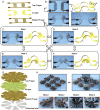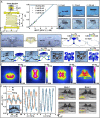Rapidly deployable and morphable 3D mesostructures with applications in multimodal biomedical devices
- PMID: 33836614
- PMCID: PMC7980465
- DOI: 10.1073/pnas.2026414118
Rapidly deployable and morphable 3D mesostructures with applications in multimodal biomedical devices
Abstract
Structures that significantly and rapidly change their shapes and sizes upon external stimuli have widespread applications in a diversity of areas. The ability to miniaturize these deployable and morphable structures is essential for applications in fields that require high-spatial resolution or minimal invasiveness, such as biomechanics sensing, surgery, and biopsy. Despite intensive studies on the actuation mechanisms and material/structure strategies, it remains challenging to realize deployable and morphable structures in high-performance inorganic materials at small scales (e.g., several millimeters, comparable to the feature size of many biological tissues). The difficulty in integrating actuation materials increases as the size scales down, and many types of actuation forces become too small compared to the structure rigidity at millimeter scales. Here, we present schemes of electromagnetic actuation and design strategies to overcome this challenge, by exploiting the mechanics-guided three-dimensional (3D) assembly to enable integration of current-carrying metallic or magnetic films into millimeter-scale structures that generate controlled Lorentz forces or magnetic forces under an external magnetic field. Tailored designs guided by quantitative modeling and developed scaling laws allow formation of low-rigidity 3D architectures that deform significantly, reversibly, and rapidly by remotely controlled electromagnetic actuation. Reconfigurable mesostructures with multiple stable states can be also achieved, in which distinct 3D configurations are maintained after removal of the magnetic field. Demonstration of a functional device that combines the deep and shallow sensing for simultaneous measurements of thermal conductivities in bilayer films suggests the promising potential of the proposed strategy toward multimodal sensing of biomedical signals.
Keywords: Lorentz force; deployable and morphable 3D mesostructures; instability; magnetic force; mechanically guided assembly.
Conflict of interest statement
The authors declare no competing interest.
Figures





References
-
- Chen T., Bilal O. R., Lang R., Daraio C., Shea K., Autonomous deployment of a solar panel using elastic origami and distributed shape-memory-polymer actuators. Phys. Rev. Appl. 11, 064069 (2019).
-
- Sakovsky M., Pellegrino S., Mallikarachchi H. M. Y. C., “Folding and deployment of closed cross-section dual-matrix composite booms” in 3rd AIAA Spacecraft Structures Conference, (American Institute of Aeronautics and Astronautics, 2016), pp. 1–18.
-
- Fung Y. C., Biomechanics: Circulation (Springer, New York: ), ed. 2, 1997).
-
- Yu X., et al. ., Needle-shaped ultrathin piezoelectric microsystem for guided tissue targeting via mechanical sensing. Nat. Biomed. Eng. 2, 165–172 (2018). - PubMed
Publication types
LinkOut - more resources
Full Text Sources
Other Literature Sources

